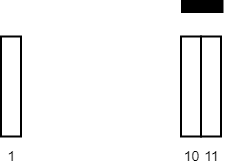You are given a 2D integer array tiles where tiles[i] = [li, ri] represents that every tile j in the range li <= j <= ri is colored white.
You are also given an integer carpetLen, the length of a single carpet that can be placed anywhere.
Return the maximum number of white tiles that can be covered by the carpet.
Example 1:
Input: tiles = [[1,5],[10,11],[12,18],[20,25],[30,32]], carpetLen = 10 Output: 9 Explanation: Place the carpet starting on tile 10. It covers 9 white tiles, so we return 9. Note that there may be other places where the carpet covers 9 white tiles. It can be shown that the carpet cannot cover more than 9 white tiles.
Example 2:
Input: tiles = [[10,11],[1,1]], carpetLen = 2 Output: 2 Explanation: Place the carpet starting on tile 10. It covers 2 white tiles, so we return 2.
Constraints:
1 <= tiles.length <= 5 * 104tiles[i].length == 21 <= li <= ri <= 1091 <= carpetLen <= 109- The
tilesare non-overlapping.
class Solution:
def maximumWhiteTiles(self, tiles: List[List[int]], carpetLen: int) -> int:
tiles.sort()
n = len(tiles)
s = ans = j = 0
for i, (li, ri) in enumerate(tiles):
while j < n and tiles[j][1] - li + 1 <= carpetLen:
s += tiles[j][1] - tiles[j][0] + 1
j += 1
if j < n and li + carpetLen > tiles[j][0]:
ans = max(ans, s + li + carpetLen - tiles[j][0])
else:
ans = max(ans, s)
s -= (ri - li + 1)
return ansclass Solution {
public int maximumWhiteTiles(int[][] tiles, int carpetLen) {
Arrays.sort(tiles, (a, b) -> a[0] - b[0]);
int n = tiles.length;
int s = 0, ans = 0;
for (int i = 0, j = 0; i < n; ++i) {
while (j < n && tiles[j][1] - tiles[i][0] + 1 <= carpetLen) {
s += tiles[j][1] - tiles[j][0] + 1;
++j;
}
if (j < n && tiles[i][0] + carpetLen > tiles[j][0]) {
ans = Math.max(ans, s + tiles[i][0] + carpetLen - tiles[j][0]);
} else {
ans = Math.max(ans, s);
}
s -= (tiles[i][1] - tiles[i][0] + 1);
}
return ans;
}
}class Solution {
public:
int maximumWhiteTiles(vector<vector<int>>& tiles, int carpetLen) {
sort(tiles.begin(), tiles.end());
int s = 0, ans = 0, n = tiles.size();
for (int i = 0, j = 0; i < n; ++i) {
while (j < n && tiles[j][1] - tiles[i][0] + 1 <= carpetLen) {
s += tiles[j][1] - tiles[j][0] + 1;
++j;
}
if (j < n && tiles[i][0] + carpetLen > tiles[j][0]) {
ans = max(ans, s + tiles[i][0] + carpetLen - tiles[j][0]);
} else {
ans = max(ans, s);
}
s -= (tiles[i][1] - tiles[i][0] + 1);
}
return ans;
}
};func maximumWhiteTiles(tiles [][]int, carpetLen int) int {
sort.Slice(tiles, func(i, j int) bool { return tiles[i][0] < tiles[j][0] })
n := len(tiles)
s, ans := 0, 0
for i, j := 0, 0; i < n; i++ {
for j < n && tiles[j][1]-tiles[i][0]+1 <= carpetLen {
s += tiles[j][1] - tiles[j][0] + 1
j++
}
if j < n && tiles[i][0]+carpetLen > tiles[j][0] {
ans = max(ans, s+tiles[i][0]+carpetLen-tiles[j][0])
} else {
ans = max(ans, s)
}
s -= (tiles[i][1] - tiles[i][0] + 1)
}
return ans
}
func max(a, b int) int {
if a > b {
return a
}
return b
}

